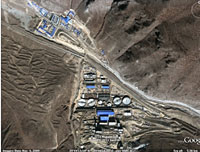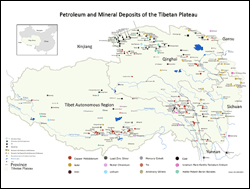
Exploiting Tibet's Resources |
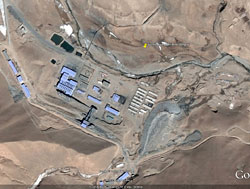
35 18 27 N, 99 47 18 E
Saishitang Copper Mine, Qinghai
Saishitang is an example of typical Chinese medium-sized mine. |

33 39 15 N, 104 04 00 E
Manaoke Gold Mine, Ngawa, Sichuan |
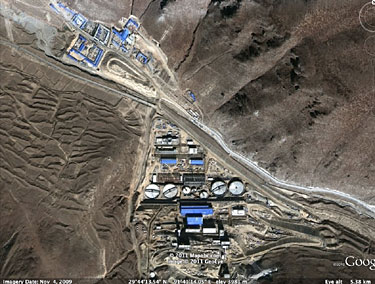
29 43.5892 N, 91 41.2949 E
Processing plant for mining at Gyama, Medrogunkar, near Lhasa. There have been clashes between Tibetans and miners over water diversion for mining at Gyama. |

29 41.3724 N, 91 45.1097 E
Open-pit mining at Gyama, Medrogunkar, near Lhasa. Copper, Gold, Molybdenum and Zinc are mined at Gyama. On March 29, 2013, in an outlying section of Gyama, an open-pit mine collapsed, causing a massive avalanche that buried 83 miners. |

Gyama Mine tailings storage:
toxic sludge is poured at the top of the hill (lower left) and goes downhill to the tailings dam (upper right). The tailings dam may last 50 years, or it may leak before that—leaking pollutants into the Gyama River, and then on into the Lhasa River. |
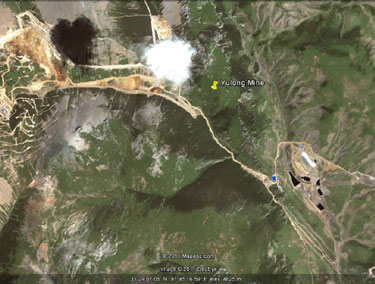
31 24 44 N, 97 44 01 E
Yulong Copper Mine is located in Chamdo Prefecture, in the eastern part of Tibet Autonomous Region. It is China's largest copper deposit. It is owned by several Chinese governmental and private companies: the two largest shareholders are Western Mining Company and the Zijin Mining Group Company. |
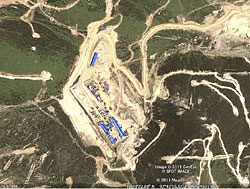
Trucks at open-pit mining at Yulong. Copper is an essential element used in the making of UHV power-lines. UHV power-lines are used to transfer hydro power over long distances—from the Tibetan plateau to power-hungry industrial zones in eastern China.
|
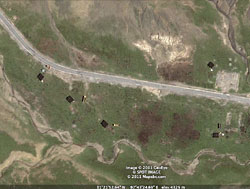
Yulong Copper Mine is located on a mountain top. Near the base of the mountain is a river, and what appears to be a traditional nomad grazing area with black (made of yak hair) tents and yaks visible. Intense activity at Yulong Copper Mine will impact the region—particularly leading to pollution of the nearby river and grasslands. |
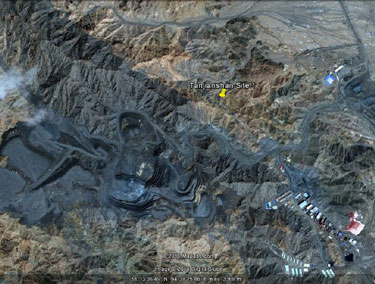
38 13 01 N, 94 37 24 E
Tanjianshan Gold Mine, in NW Qinghai province, is owned by Eldorado Gold Corp (Canada) (90%), Qinghai Number One Geological Brigade (5%), and Dachaidan Gold Mine (5%). |

This is a tailings pond at Tanjianshan gold mine. The waste goop created when concentrating the ore goes into this swimming-pool-like structure. In other words, rampant pollution. Tianjanshan is located in remote desert: the population here consists primarily of Chinese immigrant workers. |
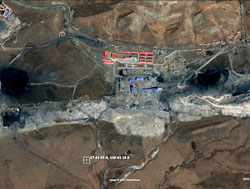
37 41 03 N, 100 43 18 E
Mole Coal Mine, Qinghai
Recent start-up of large-scale coal mines on the Tibetan plateau is a worrisome development for the environment. |
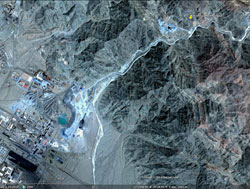
37 19 17 N, 95 34 28 E
Xitieshan Lead Zinc Mine, Qinghai
Xitieshan Mine is a core asset of the state-controlled Western Mining Group and one of China's most important mines. |
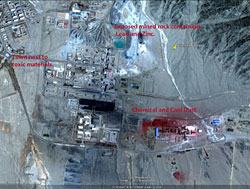
Xitieshan pollution
This Google Earth image illustrates how little consideration is given by the Western Mining Company, its owner, to the environment or health. You can see that coal and chemical dust is flying all over, and mined rock containing lead and zinc sitting next to the town. This implies that the company, which is controlled by the CCP government, isn't worried about such things. |
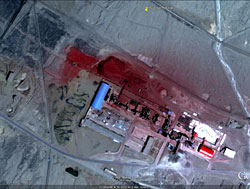
Xitieshan pollution: satellite close-up
China is notorious for its heavy industrial pollution. In this case the regulator (the government) is the company. Health and the environment are low priorities. |
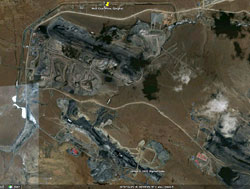
38 08 05 N, 99 08 13 E
Muli Coal Mine, Qinghai
The recent development of Muli Coal Mine by state-owned Minmetals is an indication that China's government intends to continue use coal as a dirty source of energy. |
|
|
